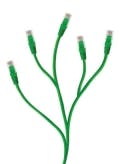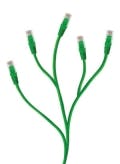From the June, 2012 Issue of Cabling Installation & Maintenance Magazine
Companies looking to deploy environmentally friendly cables, especially across multiple geographies, are challenged to accomplish that objective.
By Tom Aubin, Volex
Becoming environmentally friendly has been on the wish list of many firms for a number of years now. Ironically, despite the amount of public and political interest in seeing “greener” electronic products being sold, currently available cable assemblies as well as interconnects for applications including data, video, audio and radio-frequency often are still not very “green.” For manufacturers, making these components environmentally friendly has become a multi-territory, multi-legislature nightmare. Those challenges filter through to system installers and end users who desire to have environmentally friendly communications systems.
This article primarily discusses the challenges that face companies in all spheres—manufacturers, system designers and installers, and user organizations—as they look to gain eco-compliance.
The first misconception to tackle when looking for green cabling or interconnects is what it actually means to be “green.” Although plastics are used everywhere, from consumer electronics to children’s toys, the type of plastics can vary dramatically.
Two of the frequently present groups of chemical components that can cause environmental issues are called halogens and phthalates. The halogens include chlorine and bromine, and are used as flame retardants. Chlorine in particular is a key part of polyvinylchloride, better known as PVC, which is the most widely used plastic in cabling.
The benefit of PVC is that it’s a self-extinguishing plastic. On the down side, when PVC does burn it produces the extremely hazardous substances of dioxin and hydrogen chloride gas, as well as approximately 100 other toxic compounds. Not only would the toxic fumes given off when the cables burn be dangerous to occupants in the building, but the dioxin contamination could persist for decades afterwards.
There is also the problem when outdated electronic products are thrown out. Many of these will end up in landfill, although there are initiatives to try to eliminate this, like Europe’s WEEE (Waste Electrical and Electronic Equipment) directive, which aims to reduce the amount of electrical and electronic equipment being produced to encourage everyone to reuse, recycle and recover it. But any hardware that does end up in landfill will break down over time and then the harmful chemicals can leak into the environment.
Phthalates, also known as phthalate ester, are often used as plasticizers in plastics such as PVC to increase flexibility. However, phthalates can leach out of the polymeric material during manufacturing and during use—and then be ingested, inhaled or absorbed through the skin. The possible health hazards include damage to organs, developmental abnormalities and increased rates of asthma and allergic diseases.
With such potential dangers it is understandable that companies and the public at large are increasingly concerned about where such chemicals are used and in what quantities. Organizations such as Greenpeace also raise public awareness by providing information such as their Guide to Greener Electronics, which ranks the top 18 manufacturers of personal computers, mobile phones, TVs and game consoles according to their policies on toxic chemicals, recycling and climate change. It has been a powerful way to name and shame corporations, gaining media coverage in many countries worldwide. No one wants their company to appear on the wrong side of Greenpeace’s list.
Green has been made a vitally important issue. Consumers are now savvy to the environmental credentials of manufacturers and their products, and are putting pressure on them to be more ecologically responsible.
What this has done is fuel companies’ green aspirations and instigate a revamping of brands to not only appease the electronics-buying public, but also the firms’ stakeholders. The problem is that “going green” is not as simple as it might appear. There is not a clear cut definition of what makes a product ecologically friendly. For electronics manufacturers, sourcing cable assemblies, cords and interconnects from a firm with the necessary multi-territory legislative and supply-chain experience can help them navigate their way through the complexities.
Setting standards
Let’s look at the example of halogen-free cables, which has become a hot topic. Replacing traditional PVC cables with cables that avoid the reliance on chlorine is a difficult problem. Our research division, which is in Singapore, spent literally many person-years (as opposed to person-hours) exploring a vast variety of compounds that could be used to replace PVC while still providing the same performance.
One of the biggest problems is that there is not a worldwide de-facto standard that defines the requirements for halogen-free cords. Particularly with the power cords that are part of many electronic products, each region of the world has a different set of regulations or legislation that defines cable-material specification.
In Japan there is JCS4509, which states that the jacket and insulation on a cable must be made of either flame-retardant polyolefin or ethylene rubber.
The United States and Canada specify the use of a thermoplastic elastomer, or TPE, in their UL 62/CSA 22.2 safety standard for flexible cords.
It is different again in Europe, where HD 21.14.S1 does not just specify the use of a thermoplastic compound; it also has extra tests for pH and the amount of halogen acid gas emissions.
It is not better for phthalate-free products, often used in power cords for game consoles as one example. If you take just the United States, there is a dazzling array of different safety codes and legislative acts that are applicable, both country-wide and also at a state level.
The United States Toxic Substances Control Act provides the country’s Environmental Protection Agency with the authority to require manufacturers to report and keep records of potentially harmful chemical substances and mixtures. There currently is a motion to add eight phthalate compounds to the Act.
On top of that, there is Section 108 of the Consumer Product Safety Improvement Act (CPSIA), which sets a limit of 0.1 percent for three phthalate compounds: DEHP, DBP and BBP (Bis[2-ethylhexyl] phthalate, Dibutyl phthalate and Benzyl butyl phthalate). And if the item can be placed in a child’s mouth, then the following also must be less than 0.1 percent: DINP (Diisononyl phthalate), DIDP (Diisodecyl phthalate), and DnOP (Di[n-octyl] phthalate).
Then on a state level, California for example has a Health and Safety Code, which completely bans the six phthalates listed in the CPSIA in all products for children under the age of three—an initiative of the state’s Department of Toxic Substances Control, called “California Green Chemistry,” which aims to reduce the production of hazardous substances, and California Proposition 65, which will require manufacturers to notify authorities if they use substances like those described here.
Then there is the additional pressure brought by environmental organizations like Greenpeace, which, although it may not be backed by legislation, still significantly sways public opinion and the world’s media.
Manufacturing implications
This combination of country-by-country regulations plus the array of voluntary green measures is putting an enormous burden on product-design teams to get what used to be seen as “simple” cable assemblies, interconnects and power cords for each new product. For example, we at Volex have created a portfolio of halogen-free cables and connectors for approximately 40 different regions. Building that portfolio has required us to constantly develop new products to respond to the demand that we have had from our clients, the manufacturers of electronic products and systems. By the way, I cannot stress enough the importance of testing. It is a process that can take days, and a substantial financial investment, to complete. Tests are conducted against a couple dozen standards. If a product fails, it’s back to the drawing board.
Companies of all types—manufacturers and users alike—should also carefully consider that being “green” is not cheap. Currently, in rough terms, a company that moves from using a traditional PVC cord to using halogen-free TPE cords will see an increase in price between three and five times. There is also a longer lead time through the product supply chain, because halogen-free materials are only produced by a select number of sources. For many electronic-product manufacturers, these materials then must be imported into manufacturing locations such as China.
At the moment, the current high price for halogen-free products means that only premium brands see themselves as able to afford to invest in such solutions. But we believe it is likely that demand for green products will force many other manufacturers to move to more environmentally friendly materials. For firms facing the pressures of moving halogen-free products with which they have little or no experience, the best move will be to source these products from cable-assembly and interconnect partners.
Tom Aubin is chief technology officer with Volex (www.volex.com).

